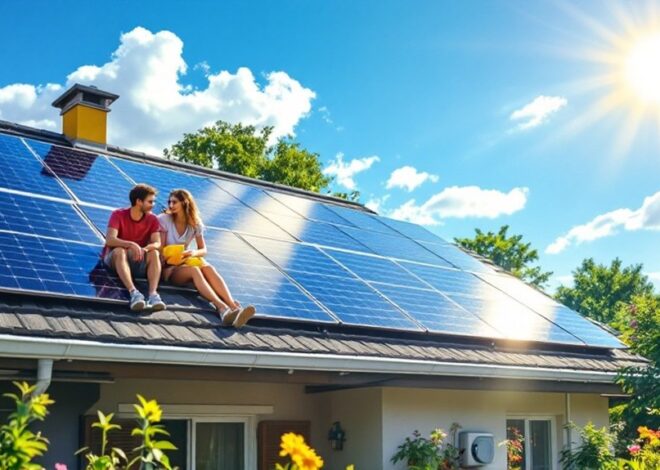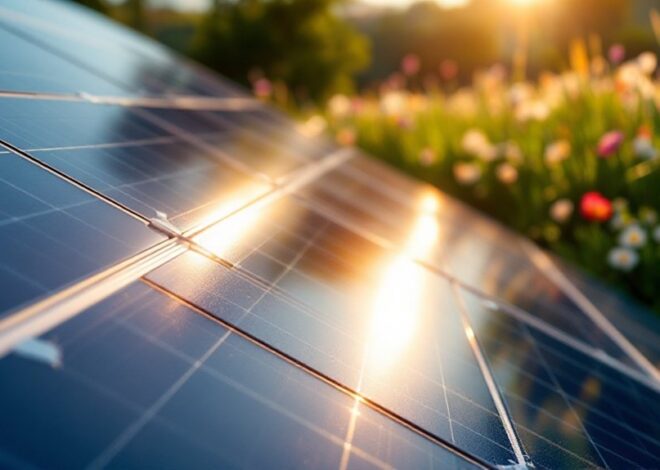
What Makes Solar Panels Efficient and Effective?
Solar panels achieve efficiency and effectiveness through various factors. High-quality materials, particularly monocrystalline silicon, play a significant role. The design of the panels, along with their installation angle and orientation, further influences performance. Additionally, the choice of inverters and regular maintenance can enhance energy conversion. Understanding these elements is essential for optimizing solar energy systems. What specific techniques and advancements contribute most to maximizing output?
Understanding Solar Panel Technology
Although solar panel technology has advanced considerably in recent years, understanding its fundamental principles remains important for consumers and industry professionals alike. Solar panels convert sunlight into electricity through the photovoltaic effect, where semiconductor materials generate electric currents upon exposure to light. The efficiency of this conversion is influenced by several factors, including the angle of sunlight, temperature, and the quality of the materials used. Key components such as inverters and mounting systems also play essential roles in optimizing energy capture and delivery. By grasping these basic concepts, stakeholders can make informed decisions regarding installation, maintenance, and energy production expectations. This foundational knowledge is significant for maximizing the benefits of solar energy in various applications. Moreover, investments in renewable energy are expected to continue growing, driving further advancements in solar technology.
The Role of Solar Cell Materials
The choice of materials in solar cells notably influences their efficiency and performance. Various types of solar materials, such as monocrystalline silicon, polycrystalline silicon, and thin-film technologies, each possess unique characteristics that affect energy conversion rates. Understanding these materials and the factors that impact their efficiency is essential for optimizing solar panel technology. Additionally, the rise of renewable energy contributes significantly to the adoption of solar technology as a sustainable practice.
Types of Solar Materials
Solar cell materials play an essential role in determining the efficiency and effectiveness of solar panels. Various types of materials are employed in the manufacturing of solar cells, each with distinct properties. The most common materials include monocrystalline silicon, known for its high efficiency and longevity; polycrystalline silicon, which is more affordable but slightly less efficient; and thin-film solar cells, made from materials like cadmium telluride or amorphous silicon, offering flexibility and lightweight options. Emerging technologies also explore perovskite materials, which promise higher efficiency at lower costs. Each material type influences not only the performance of the solar panel but also its application, cost, and overall sustainability, making the choice of solar cell material critical in solar energy systems.
Efficiency Factors Explained
Factors influencing solar panel efficiency are closely tied to the materials used in solar cell production. Commonly used materials include silicon, cadmium telluride, and thin-film compounds, each exhibiting unique properties that affect performance. Silicon, for instance, is favored for its high efficiency and stability, while cadmium telluride offers a lower cost alternative with competitive performance. The purity and crystalline structure of these materials considerably impact their ability to convert sunlight into electricity. Additionally, advancements in material science, such as the development of perovskite solar cells, hold promise for future efficiency gains. The interplay between these materials and the design of solar cells ultimately determines the overall effectiveness and longevity of solar panels in harnessing solar energy.
Importance of Panel Design
The design of solar panels markedly impacts their overall efficiency. Factors such as the materials used in construction, along with the shape and orientation of the panels, play an essential role in optimizing energy capture. Analyzing these design elements reveals their influence on performance and durability. Additionally, embracing minimalism in design can lead to more efficient use of resources, enhancing sustainability in solar technology.
Materials Used in Construction
Advancements in materials science have greatly influenced the efficiency and durability of solar panels. The primary materials used in constructing solar panels, such as silicon, cadmium telluride, and copper indium gallium selenide, play an essential role in their overall performance. Silicon, being the most widely used material, offers excellent conductivity and longevity. Meanwhile, thin-film technologies utilizing cadmium telluride and copper indium gallium selenide provide flexibility and lightweight options, enhancing installation versatility. The encapsulants and backing materials also contribute considerably, protecting the solar cells from environmental factors while ensuring longevity and peak performance. These innovations in material selection and engineering continue to improve energy conversion rates and reliability, making solar panels a more viable renewable energy source.
Shape and Orientation Factors
While solar panel efficiency is primarily influenced by the materials used, the shape and orientation of the panels also play a crucial role in maximizing energy capture. The design of solar panels, including their surface area and angle, can greatly affect the amount of sunlight they receive. For instance, flat panels may underperform in regions with low sun angles, while angled panels can enhance exposure throughout the day. Additionally, the shape influences airflow and heat dissipation; streamlined designs can reduce heat buildup, improving overall efficiency. Proper orientation towards the sun, adjusted seasonally, allows for peak performance. Therefore, thoughtful design considerations regarding shape and orientation are essential for achieving the highest efficiency in solar energy systems.
Impacts of Installation Angle and Orientation
Proper installation angle and orientation are vital factors that greatly influence solar panel efficiency. The angle at which solar panels are installed can markedly affect their ability to capture sunlight. Typically, a tilt angle equal to the latitude of the installation location maximizes exposure throughout the year. Additionally, the orientation of panels towards the equator—south in the Northern Hemisphere and north in the Southern Hemisphere—ensures ideal sunlight absorption. Seasonal adjustments may further enhance efficiency, as the sun’s position changes. Variations in angle and orientation can lead to considerable differences in energy production. Therefore, careful consideration of these factors is essential for maximizing solar panel performance and achieving desired energy outputs. Proper planning can lead to enhanced overall system effectiveness. Moreover, work-life balance is increasingly important for individuals to sustain motivation and productivity while managing their energy usage effectively.
The Significance of Inverter Efficiency
Inverter efficiency plays an essential role in the overall performance of solar energy systems, as it directly impacts the amount of electricity that can be converted from the direct current (DC) generated by solar panels to usable alternating current (AC). A high-efficiency inverter minimizes energy losses during this conversion process, ensuring that a greater proportion of the generated electricity is utilized. Inverter performance is typically measured by its efficiency rating, often expressed as a percentage; the higher the rating, the more effective the inverter is at transforming energy. Additionally, inverter efficiency can influence the return on investment for solar installations, as reduced losses lead to increased energy savings and overall system effectiveness. Consequently, selecting a quality inverter is vital for maximizing solar energy potential. Furthermore, AI technology in renewable energy is enhancing system efficiencies and optimizing performance.
The Influence of Temperature on Performance
Temperature notably affects the performance of solar panels, with higher temperatures generally leading to decreased efficiency. Solar cells are typically designed to operate ideally at cooler temperatures. When the temperature rises, the semiconductor materials within the solar cells become less effective at converting sunlight into electricity. This phenomenon is characterized by a reduction in voltage output, which can greatly impact overall energy production. Conversely, cooler temperatures can enhance the efficiency of solar panels, allowing for increased energy generation. It is essential for solar panel designers and users to take into account the local climate when evaluating solar panel performance. Understanding the relationship between temperature and solar panel efficiency can guide decisions on installation and energy expectations in different environments.
Maintenance and Care for Optimal Output
Although solar panels are designed to withstand various environmental conditions, regular maintenance is essential for guaranteeing ideal output. Keeping the panels clean is critical, as dirt, dust, and debris can considerably reduce their efficiency. Routine inspections should be conducted to identify any potential issues, such as loose connections or damaged components. Additionally, monitoring the inverter’s performance helps guarantee the entire system operates effectively. It is advisable to schedule professional maintenance at least once a year to address any technical concerns and perform thorough cleaning. Homeowners should also be aware of surrounding vegetation, as overhanging branches can cast shadows and diminish solar energy capture. By adhering to these maintenance practices, solar panel longevity and efficiency can be maximized.
Government Incentives and Their Effect on Adoption
As governments worldwide increasingly recognize the importance of renewable energy, various incentives have emerged to encourage the adoption of solar technology. These incentives typically include tax credits, rebates, and grants, which markedly lower the initial financial burden for consumers and businesses. By reducing installation costs, these programs make solar energy more accessible, thereby accelerating adoption rates. Additionally, net metering policies allow solar users to sell excess energy back to the grid, further enhancing the financial appeal of solar systems. These governmental measures not only promote environmental sustainability but also stimulate economic growth by creating jobs in the solar industry. Overall, effective government incentives play an essential role in driving the shift to renewable energy and enhancing solar panel efficiency.
Frequently Asked Questions
How Long Do Solar Panels Typically Last Before Needing Replacement?
Solar panels typically last between 25 to 30 years before requiring replacement. Their longevity depends on factors such as quality, installation, and maintenance, with many retaining significant efficiency even after decades of use.
Can Solar Panels Work in Cloudy or Rainy Weather?
Solar panels can indeed function in cloudy or rainy weather, although their efficiency decreases. They still capture diffuse sunlight, allowing for energy production, albeit at lower levels compared to sunny conditions, maintaining some operational capacity.
What Is the Average Return on Investment for Solar Panels?
The average return on investment for solar panels typically ranges from 10% to 20%, depending on factors such as installation costs, energy savings, local incentives, and electricity rates, providing a financially attractive option for homeowners.
Do Solar Panels Require a Lot of Maintenance?
Solar panels generally require minimal maintenance. Regular cleaning and occasional inspections suffice to guarantee peak performance. With no moving parts, they tend to last for decades, providing a low-maintenance energy solution for homeowners and businesses alike.
How Do Solar Panels Affect Property Value?
Solar panels can positively influence property value by enhancing energy efficiency and attracting eco-conscious buyers. Homeowners may experience increased market appeal and potential financial savings, making solar installations a valuable investment in real estate.
Conclusion
To summarize, the efficiency and effectiveness of solar panels are influenced by a combination of advanced materials, thoughtful design, and precise installation. By optimizing factors such as angle, orientation, and inverter performance, solar systems can achieve maximum energy conversion. Regular maintenance further guarantees longevity and output. As technology continues to evolve and government incentives promote adoption, the future of solar energy holds significant promise for sustainable energy solutions.



